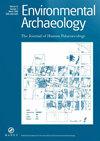Animal Indoor Penning in the Eastern Pyrenees: The Case-study of Late Iron Age Tossal de Baltarga, Cerdanya
IF 1.1
3区 地球科学
0 ARCHAEOLOGY
引用次数: 0
Abstract
ABSTRACTOver the last decades, micro-archaeological and ethnoarchaeological approaches have demonstrated the importance of animal dung deposits for reconstructing past human lifeways, primarily within caves and rock-shelters. The case study of Tossal de Baltarga (eastern Pyrenees) provides evidence from simultaneous storage and penning, along with the in situ remains in anatomical connection of several ovicaprines and a horse within a building destroyed by fire, dating to the second half of the third century BC. The current study provides new evidence for animal management and organisation of space at the site through examination in micromorphological thin-section and integrated phytolith and dung spherulite analyses. Micromorphological results reveal spatial variations in dung accumulation, possibly related to differences in the use of space. Phytolith records further provide insights into herbivorous regimes, dominated by a range of grass matter suggested to derive from fodder and/or grazing through the penning lifetime. This integrated approach contributes to the understanding of depositional pathways and taphonomy of penning deposits within built environments, critical for the reconstruction of activity areas and practices related to animal management, foddering/grazing patterns, site formation processes, concepts of space within the settlement, health and the complexity of interactions between people and animals in mountain areas.KEYWORDS: Iron ageEastern Pyreneeslivestock penningmicromorphologyphytolithsdung spherulites AcknowledgementsThis research has received funding from the Spanish Ministry of Science and Innovation (PID2021-122879OB-I00), and the Generalitat de Catalunya, ARQ001SOL-109-2022 (437 CU00050, PATCA-3).Disclosure StatementNo potential conflict of interest was reported by the author(s).Additional informationFundingThis work was supported by Generalitat de Catalunya: [Grant Number ARQ001SOL-109-2022 (437 CU00050, PATCA-3)]; Agency for Management of University and Research Grants (AGAUR): [Grant Number 2021SGR 501]; Spanish Ministry of Science and Innovation: [Grant Number PID2021-122879OB-I00].Notes on contributorsMarta PortilloDr Marta Portillo is a tenured scientist at the Spanish National Research Council (IMF-CSIC) specialised in phytoliths and calcitic microfossils in integration with geoarchaeological methods, as well as with experimental and ethnoarchaeological approaches. Her research focuses on human-environment interactions and cultural, economic and technological innovations in the Western Mediterranean and the Near East. She served on the board of the International Phytolith Society (IPS). She is the coordinator of the Archaeology of Social Dynamics Research Group at the IMF-CSIC (2021SGR 501).Joaquim Sisa-López de PabloDr Joaquim Sisa-López de Pablo received his Ph.D. at the Autonomous University of Barcelona (UAB). He is a geoarchaeologist specialised in soil micromorphology. His research focuses on the study of architecture and the built environment and its implications regarding human–environment interrelations and living conditions in the Western Mediterranean and Southwest Asia.Joan OllerDr Joan Oller is a lecturer in ancient history at the UAB. He is a specialist in landscape archaeology and the study of the Ancient Roman territory. He has mainly studied these subjects from an archaeological perspective and is the director of different archaeological sites and projects in Spain, for instance in the Catalan Pyrenees and the Roman cities of La Mesa (Burgos) and Colonia Augusta Firma Astigi (Sevilla). He is also the director of the Sikait Project, an archaeological concession in the Egyptian Eastern Desert.Jordi MoreraDr Jordi Morera is an associate lecturer in ancient history at the UAB. He is a specialist in the Iberian period and the Romanisation, especially of the Catalan Pyrenees. He has mainly studied these issues through archaeological research programmes in several sites and he has been the director of the study of different Roman villas in Catalonia.Oriol OlestiDr Oriol Olesti is a senior lecturer in ancient history at the UAB and an associate lecturer at the Open University of Catalonia (UOC, Master of Ancient Mediterranean Cultures). He was a visiting scholar at the Classics Faculty, University of Oxford. He is currently the director of two Spanish and Catalan research projects and the former director of fifteen. His research focuses on the study of Ancient landscapes as historical documents to understand the relationships between Ancient societies and their territories and resources in Hispania, and also in southern France, Morocco and Syria.东比利牛斯山脉的动物室内围栏:铁器时代晚期托萨尔·德·巴尔塔加的案例研究
在过去的几十年里,微观考古学和民族考古学的方法已经证明了动物粪便沉积物对重建过去人类生活方式的重要性,主要是在洞穴和岩石避难所中。对Tossal de Baltarga(东比利牛斯山脉)的案例研究提供了同时储存和围栏的证据,以及在一幢被大火烧毁的建筑中发现的几只卵巢和一匹马的解剖联系的原位遗骸,可追溯到公元前三世纪下半叶。目前的研究通过显微形态薄切片检查和综合植物岩和粪便球粒分析,为动物管理和现场空间组织提供了新的证据。微形态学结果揭示了粪便积累的空间差异,可能与空间利用的差异有关。植物岩记录进一步提供了对草食制度的见解,由一系列草食物质主导,这些草食物质被认为是在围栏的一生中来自饲料和/或放牧。这种综合方法有助于理解建筑环境中沉积物的沉积路径和埋藏规律,对于重建活动区域和与动物管理、饲养/放牧模式、场地形成过程、定居点内空间概念、健康以及山区人与动物之间相互作用的复杂性相关的实践至关重要。本研究获得了西班牙科学与创新部(pid2021 - 122879b - i00)和加泰罗尼亚政府的资助,ARQ001SOL-109-2022 (437 CU00050, PATCA-3)。披露声明作者未报告潜在的利益冲突。本研究由加泰罗尼亚政府资助:[授权号ARQ001SOL-109-2022 (437 CU00050, PATCA-3)];大学和研究基金管理机构(AGAUR):[批准号2021SGR 501];西班牙科学与创新部:[批准号PID2021-122879OB-I00]。Marta Portillo博士是西班牙国家研究委员会(IMF-CSIC)的终身科学家,专门研究植物岩和钙质微化石,结合地质考古方法,以及实验和民族考古方法。她的研究重点是西地中海和近东的人与环境的相互作用以及文化、经济和技术创新。她曾担任国际植石学会(IPS)董事会成员。她是国际货币基金组织- csic社会动力学考古研究小组(2021SGR 501)的协调员。Joaquim Sisa-López de pablojoaquim Sisa-López de Pablo博士毕业于巴塞罗那自治大学(UAB)。他是一位专门研究土壤微观形态学的地质考古学家。他的研究主要集中在西地中海和西南亚的建筑和建成环境及其对人与环境相互关系和生活条件的影响。Joan Oller博士是牛津大学古代史讲师。他是景观考古学和古罗马领土研究方面的专家。他主要从考古学的角度研究这些主题,是西班牙不同考古遗址和项目的负责人,例如在加泰罗尼亚比利牛斯山脉和罗马城市拉梅萨(布尔戈斯)和殖民地奥古斯塔Firma Astigi(塞维利亚)。他也是Sikait项目的负责人,Sikait项目是埃及东部沙漠的一个考古特许权。Jordi Morera是牛津大学古代史副讲师。他是伊比利亚时期和罗马化的专家,特别是加泰罗尼亚的比利牛斯山脉。他主要通过几个地点的考古研究项目来研究这些问题,他一直是加泰罗尼亚不同罗马别墅研究的负责人。Oriol Olesti博士是UAB古代史高级讲师,也是加泰罗尼亚开放大学(UOC,古地中海文化硕士)的副讲师。他是牛津大学古典学院的访问学者。他目前是两个西班牙和加泰罗尼亚研究项目的主任,也是15个研究项目的前任主任。他的研究重点是将古代景观作为历史文献进行研究,以了解西班牙、法国南部、摩洛哥和叙利亚的古代社会与其领土和资源之间的关系。
本文章由计算机程序翻译,如有差异,请以英文原文为准。
求助全文
约1分钟内获得全文
求助全文
来源期刊

Environmental Archaeology
GEOSCIENCES, MULTIDISCIPLINARY-
CiteScore
4.80
自引率
0.00%
发文量
32
期刊介绍:
Environmental Archaeology: The Journal of Human Palaeoecology aims to publish contributions on all aspects of environmental archaeology, from methodology to synthesis and theory.
Environmental Archaeology is an international peer-reviewed periodical which welcomes contributions that consider the interaction between humans and their environment in the archaeological and historical past. This broad scope embraces papers covering a range of environmental specialisms within archaeology, such as archaeobotany, archaeozoology (both vertebrate and invertebrate), palynology, geoarchaeology, biological anthropology, as well as more synthetic and theoretical approaches to the past human environment. Assemblage and site reports are not encouraged unless these can demonstrate significant new insights in environmental archaeology. Contributions may take the form of substantial research papers or shorter reports and may include, for instance, new techniques, philosophical discussions, current controversies and suggestions for new research. The journal also provides its readership with critical appraisal of recent academic scholarship through its regular books review section.
 求助内容:
求助内容: 应助结果提醒方式:
应助结果提醒方式:


